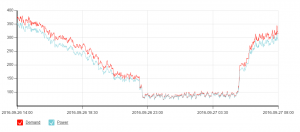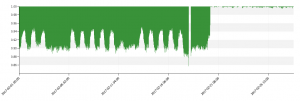Sanlam Sky Houghton Case Study
Our energy intelligence meter was installed on the main incomer of the Sanlam Sky building in March 2012. The data was mostly used to report on sustainability targets for the Sanlam Environmental Committee.
Following the success of active interventions at other sites (Sanlam Head Office, Santam Head Office, Santam Auckland Park) the Sanlam/Santam Energy Forum, of which Power-Star forms a part, decided to focus efforts on this building.
Base-load optimization
The first area of optimization was identified to be off-peak loads. The following is a graph of power usage over a week before any interventions:

The data showed that on average during the day when all employees were present and working the load was about 350 kW. During the night when there was no economic activity taking place on site, and the only employees present were security personnel, the load was running at approximately 200-220 kW. This implied that there was a significant opportunity for off-peak reduction.
To find the cause a Power-Star team was sent in after hours to investigate what was running on site. The main goal was to switch off as much non-critical equipment as possible to minimise the load. By systematically working through the site we were able to bring down the load to an average of 80 kW:

The main source of the extra load was lights, due to very few switches being installed. To switch off the lights we needed to go down to DB level. The answer was simple – install basic light switches and instruct security to switch off lights when the buildings are empty. The results were as follows:

The payback period of the project was 1.5 days – and showed a 25% reduction in total energy use.
Power Factor Correction
Due to the way in which maximum demand and reactive energy charges are billed in the area and the low power factor on site, there was a good opportunity to install power factor correction. The following chart shows power factor before and after installation:

The power factor correction reduced demand and reactive energy charges by R9 000-R10 000 per month, for a project payback without escalations of 11.5 months
Billing correction
While the other projects were running we were also investigating an opportunity where we found a difference between what the Power-Star meters were saying Sanlam Sky should be billed, versus what was actually being billed. The history of billing was analyzed and the overbilling by the council was found to be significant.
We followed a process of installing check metering to ensure the Power-Star meter was accurate and using this set of evidence approached City Council. The result of the negotiation was a credit of R1 150 000 that was applied to the Sanlam Sky account.
Next Steps
There are two main projects we are working on now. The first is to look at changing some of the inefficient security lights to efficient alternatives. The reason to focus on these lights is that the load factor is much higher than some of the other lights which are now being switched off at night. Using the combined expertise of the Energy Forum members we are confident that the best technology will be chosen.
The other main focus point is the analysis of the current electricity tariff. Initial indications are that there may be an opportunity to switch tariff structures to a time-of-use tariff. This would benefit our cost-saving initiatives.
Leave a comment